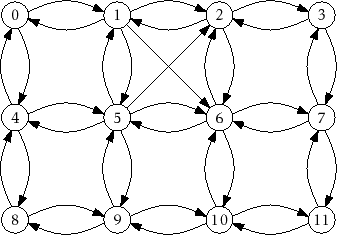12.2 AdjacencyLists: A Graph as a Collection of Lists (original) (raw)
Adjacency list representations takes a more vertex-centric approach. There are many different possible implementations of adjacency lists. In this section, we present a simple one. At the end of the section, we discuss different possibilities. In an adjacency list representation, the graph  is represented as an array,
is represented as an array,  , of lists. The list
, of lists. The list ![$ \mathtt{adj[i]}$](http://opendatastructures.org/versions/edition-0.1e/ods-java/img1540.png) contains a list of all the vertices adjacent to vertex
contains a list of all the vertices adjacent to vertex  . That is, it contains every index
. That is, it contains every index  such that
such that  .
.
int n;
List<Integer>[] adj;
AdjacencyLists(int n0) {
n = n0;
adj = (List<Integer>[])new List[n];
for (int i = 0; i < n; i++)
adj[i] = new ArrayStack<Integer>(Integer.class);
}(An example is shown in Figure 12.3.) In this particular implementation, we represent each list in  as an ArrayStack, because we would like constant time access by position. Other options are also possible. Specifically, we could have implemented
as an ArrayStack, because we would like constant time access by position. Other options are also possible. Specifically, we could have implemented  as a DLList.
as a DLList.
**Figure 12.3:**A graph and its adjacency lists
 0 1 2 3 4 5 6 7 8 9 10 11 1 0 1 2 0 1 5 6 4 8 9 10 4 2 3 7 5 2 2 3 9 5 6 7 6 6 8 6 7 11 10 11 5 9 10 4 0 1 2 3 4 5 6 7 8 9 10 11 1 0 1 2 0 1 5 6 4 8 9 10 4 2 3 7 5 2 2 3 9 5 6 7 6 6 8 6 7 11 10 11 5 9 10 4 |
|---|
The  operation just appends the value
operation just appends the value  to the list
to the list ![$ \mathtt{adj[i]}$](http://opendatastructures.org/versions/edition-0.1e/ods-java/img1540.png) :
:
void addEdge(int i, int j) {
adj[i].add(j);
}This takes constant time.
The  operation searches through the list
operation searches through the list ![$ \mathtt{adj[i]}$](http://opendatastructures.org/versions/edition-0.1e/ods-java/img1540.png) until it finds
until it finds  and then removes it:
and then removes it:
void removeEdge(int i, int j) {
Iterator<Integer> it = adj[i].iterator();
while (it.hasNext()) {
if (it.next() == j) {
it.remove();
return;
}
}
}This takes  time, where
time, where  (the degree of
(the degree of  ) counts the number of edges in
) counts the number of edges in  that have
that have  as their source.
as their source.
The  operation is similar; it searches through the list
operation is similar; it searches through the list ![$ \mathtt{adj[i]}$](http://opendatastructures.org/versions/edition-0.1e/ods-java/img1540.png) until it finds
until it finds  (and returns true), or reaches the end of the list (and returns false):
(and returns true), or reaches the end of the list (and returns false):
boolean hasEdge(int i, int j) {
return adj[i].contains(j);
}This also takes  time.
time.
The  operation is very simple; It simply returns the list
operation is very simple; It simply returns the list ![$ \mathtt{adj[i]}$](http://opendatastructures.org/versions/edition-0.1e/ods-java/img1540.png) :
:
List<Integer> outEdges(int i) {
return adj[i];
}This clearly takes constant time.
The  operation is much more work. It scans over every vertex
operation is much more work. It scans over every vertex  checking if the edge
checking if the edge  exists and, if so, adding
exists and, if so, adding  to the output list:
to the output list:
List<Integer> inEdges(int i) {
List<Integer> edges = new ArrayStack<Integer>(Integer.class);
for (int j = 0; j < n; j++)
if (adj[j].contains(i)) edges.add(j);
return edges;
}This operation is very slow. It scans the adjacency list of every vertex, so it takes  time.
time.
The following theorem summarizes the performance of the above data structure:
Theorem 12..2 The AdjacencyLists data structure implements the Graph interface. An AdjacencyLists supports the operations
The space used by a AdjacencyLists is  .
.
As alluded to earlier, there are many different choices to be made when implementing a graph as an adjacency list. Some questions that come up include:
- What type of collection should be used to store each element of
 ? One could use an array-based list, a linked-list, or even a hashtable.
? One could use an array-based list, a linked-list, or even a hashtable. - Should there be a second adjacency list,
 , that stores, for each
, that stores, for each  , the list of vertices,
, the list of vertices,  , such that
, such that  ? This can greatly reduce the running-time of the
? This can greatly reduce the running-time of the  operation, but requires slightly more work when adding or removing edges.
operation, but requires slightly more work when adding or removing edges. - Should the entry for the edge
 in
in ![$ \mathtt{adj[i]}$](http://opendatastructures.org/versions/edition-0.1e/ods-java/img1540.png) be linked by a reference to the corresponding entry in
be linked by a reference to the corresponding entry in ![$ \mathtt{inadj[j]}$](http://opendatastructures.org/versions/edition-0.1e/ods-java/img1547.png) ?
? - Should edges be first-class objects with their own associated data? In this way,
 would contain lists of edges rather than lists of vertices (integers).
Most of these questions come down to a tradeoff between complexity (and space) of implementation and performance features of the implementation.
would contain lists of edges rather than lists of vertices (integers).
Most of these questions come down to a tradeoff between complexity (and space) of implementation and performance features of the implementation.